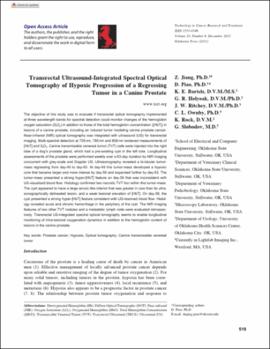| dc.contributor.author | Jiang, Zhen | |
| dc.contributor.author | Piao, Daqing | |
| dc.contributor.author | Bartels, Kenneth E. | |
| dc.contributor.author | Holyoak, G. Reed | |
| dc.contributor.author | Ritchey, Jerry W. | |
| dc.contributor.author | Ownby, CL | |
| dc.contributor.author | Rock, K | |
| dc.contributor.author | Slobodov, Gennady | |
| dc.date.accessioned | 2023-07-06T21:40:08Z | |
| dc.date.available | 2023-07-06T21:40:08Z | |
| dc.date.issued | 2011-12-01 | |
| dc.identifier | oksd_jiang_transrectal_ultrasound_integrated_spectral_2011 | |
| dc.identifier.citation | Jiang, Z., Piao, D., … Slobodov, G. (2011). Transrectal ultrasound-integrated spectrasl optical tomography of hypoxic progression of a regressing tumor in a canine prostate. Technology in Cancer Research and Treatment, 10(6), 519-531. https://doi.org/10.1177/153303461101000603 | |
| dc.identifier.issn | 1533-0346 | |
| dc.identifier.uri | https://hdl.handle.net/11244/337910 | |
| dc.description.abstract | The objective of this study was to evaluate if transrectal optical tomography implemented at three wavelength bands for spectral detection could monitor changes of the hemoglobin oxygen saturation (SₜO₂) in addition to those of the total hemoglobin concentration ([HbT]) in lesions of a canine prostate, including an induced tumor modeling canine prostate cancer. Near-infrared (NIR) optical tomography was integrated with ultrasound (US) for transrectal imaging. Multi-spectral detection at 705 nm, 785 nm and 808 nm rendered measurements of [HbT] and SₜO₂. Canine transmissible venereal tumor (TVT) cells were injected into the right lobe of a dog's prostate gland, which had a pre-existing cyst in the left lobe. Longitudinal assessments of the prostate were performed weekly over a 63-day duration by NIR imaging concurrent with grey-scale and Doppler US. Ultrasonography revealed a bi-lobular tumor-mass regressing from day-49 to day-63. At day-49 this tumor-mass developed a hypoxic core that became larger and more intense by day-56 and expanded further by day-63. The tumor-mass presented a strong hyper-[HbT] feature on day-56 that was inconsistent with US-visualized blood flow. Histology confirmed two necrotic TVT foci within this tumor-mass. The cyst appeared to have a large anoxic-like interior that was greater in size than its ultrasonographically delineated lesion, and a weak lesional elevation of [HbT]. On day-56, the cyst presented a strong hyper-[HbT] feature consistent with US-resolved blood flow. Histology revealed acute and chronic hemorrhage in the periphery of the cyst. The NIR imaging features of two other TVT nodules and a metastatic lymph node were evaluated retrospectively. Transrectal US-integrated spectral optical tomography seems to enable longitudinal monitoring of intra-lesional oxygenation dynamics in addition to the hemoglobin content of lesions in the canine prostate. © Adenine Press (2011). | |
| dc.format | application/pdf | |
| dc.language | en_US | |
| dc.publisher | SAGE Publications | |
| dc.relation.ispartof | Technology in Cancer Research and Treatment, 10 (6) | |
| dc.relation.uri | https://www.ncbi.nlm.nih.gov/pubmed/22066593 | |
| dc.rights | This material has been previously published. In the Oklahoma State University Library's institutional repository this version is made available through the open access principles and the terms of agreement/consent between the author(s) and the publisher. The permission policy on the use, reproduction or distribution of the material falls under fair use for educational, scholarship, and research purposes. Contact Digital Resources and Discovery Services at lib-dls@okstate.edu or 405-744-9161 for further information. | |
| dc.title | Transrectal ultrasound-integrated spectral optical tomography of hypoxic progression of a regressing tumor in a canine prostate | |
| dc.date.updated | 2023-07-02T13:45:42Z | |
| dc.note | open access status: Hybrid OA | |
| osu.filename | oksd_jiang_transrectal_ultrasound_integrated_spectral_2011.pdf | |
| dc.identifier.doi | 10.1177/153303461101000603 | |
| dc.description.department | Electrical & Computer Engineering | |
| dc.description.department | Veterinary Clinical Sciences | |
| dc.type.genre | Article | |
| dc.type.material | Text | |
| dc.subject.keywords | biomedical and clinical sciences | |
| dc.subject.keywords | oncology and carcinogenesis | |
| dc.subject.keywords | urologic diseases | |
| dc.subject.keywords | prostate cancer | |
| dc.subject.keywords | bioengineering | |
| dc.subject.keywords | biomedical imaging | |
| dc.subject.keywords | cancer | |
| dc.subject.keywords | good health and well being | |
| dc.subject.keywords | oncology and carcinogenesis | |
| dc.subject.keywords | oncology & carcinogenesis | |
| dc.subject.keywords | algorithms | |
| dc.subject.keywords | animals | |
| dc.subject.keywords | computer simulation | |
| dc.subject.keywords | dogs | |
| dc.subject.keywords | hypoxia | |
| dc.subject.keywords | male | |
| dc.subject.keywords | mice | |
| dc.subject.keywords | mice, inbred nod | |
| dc.subject.keywords | mice, scid | |
| dc.subject.keywords | prostate | |
| dc.subject.keywords | prostatic neoplasms | |
| dc.subject.keywords | spectroscopy, near-infrared | |
| dc.subject.keywords | tomography, optical | |
| dc.subject.keywords | ultrasonography | |
| dc.subject.keywords | venereal tumors, veterinary | |
| dc.identifier.author | ScopusID: 57199784187 (Jiang, Z) | |
| dc.identifier.author | ORCID: 0000-0003-0922-6885 (Piao, D) | |
| dc.identifier.author | ScopusID: 7005153312 | 57220465193 (Piao, D) | |
| dc.identifier.author | ResearcherID: I-1341-2013 (Piao, D) | |
| dc.identifier.author | ScopusID: 7005400149 (Bartels, KE) | |
| dc.identifier.author | ORCID: 0000-0003-2528-2748 (Holyoak, GR) | |
| dc.identifier.author | ScopusID: 6701722645 (Holyoak, GR) | |
| dc.identifier.author | ORCID: 0000-0003-0307-4673 (Ritchey, JW) | |
| dc.identifier.author | ScopusID: 7006378376 (Ritchey, JW) | |
| dc.identifier.author | ScopusID: 7006363068 (Ownby, CL) | |
| dc.identifier.author | ScopusID: 37089430000 (Rock, K) | |
| dc.identifier.author | ScopusID: 8984047600 (Slobodov, G) | |
| dc.identifier.essn | 1533-0338 | |
